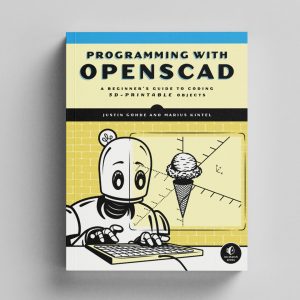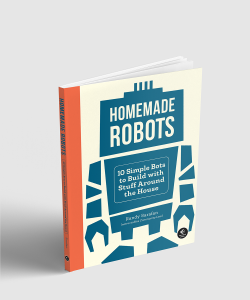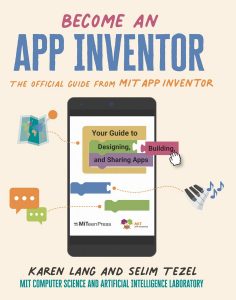There’s quite a wide mix, ranging from homemade robots to electronic warfare (I don’t think those categories would ever overlap) and other titles covering 3D-printing, writing mobile apps and Edge computing…
 Programming with OpenSCAD: A Beginners Guide to Coding 3D-Printable Objects
Programming with OpenSCAD: A Beginners Guide to Coding 3D-Printable Objects
Interested in 3D-printing, and OpenSCAD specifically, which is open source scripting-based software for creating 3D CAD objects? This book may be for you. Thanks to our Technology Editor, Steve Bush, for highlighting it. He’s our resident expert on 3D printing, so we’ve taken note. The idea of the software is to enable non-designers to more easily create 3D designs and the book is written for a wide audience (advanced school students, college students, artists and makers), without assuming prior experience in the area. It covers programming in general and 3D modeling in particular.
 Understanding Infrastructure Edge Computing
Understanding Infrastructure Edge Computing
This book may interest Gadget Masters who want to better understand edge computing and the infrastructures that can underlie it – its full title is: Understanding Infrastructure Edge Computing: Concepts, Technologies, and Considerations. Written by Alex Marcham – who apparently coined the term ‘infrastructure edge computing’ – it’s intended to provide an accessible view of the next generation of internet infrastructure. We’re talking 5G networks, city-scale AI systems, self-driving cars, drones, and industrial robots… The book covers areas such as distributed application workload operation, infrastructure and application security, and multi-access edge computing (MEC) and fog computing technologies. It also covers use cases and examples of real-world applications depending upon underlying edge infrastructure.
 Homemade Robots (built with household materials)
Homemade Robots (built with household materials)
This looks a good one – a new book called Homemade Robots. It’s sub-title is: 10 Simple Bots to Build with Stuff Around the House. Described as an easy-to-follow, all ages project book, it covers a range of mobile, autonomous bots that can be built using relatively common household materials. For example, the Skitter Bot uses a Bic pen with toothbrushes for legs (as well as a single motor and a DPDT toggle switch). The publishers, No Starch Press, write: “From the teetering Wobbler to the rolling Barreller, each bot is self-driving and has a unique personality. There’s the aptly named Inchworm Bot made of aluminum rulers; Buffer, a street sweeper-like bot that polishes the floor as it walks; and Sail Bot, which changes direction based on the wind.”
 Living with Robots – What Every Anxious Human Needs to Know
Living with Robots – What Every Anxious Human Needs to Know
This book is from MIT Press and is called Living with Robots: What Every Anxious Human Needs to Know. Due out in September, it’s designed to be a lively and accessible guide to what robots can and can’t do, looking beyond the hype, the publishers promise. It covers areas such as why robots can swim and fly but find it difficult to walk. Which robot features are inspired by animals and insects. Why we develop feelings for robots. And which human abilities are hard for robots to emulate. Basically, the authors – two robotics experts – consider how robots work and what we can reasonably expect their future capabilities to be.
 EW 105 Space Electronic Warfare
EW 105 Space Electronic Warfare
Like London buses. You wait ages for a Gadget Book to come along and then two come together. After Living with Robots, check out EW 105: Space Electronic Warfare. But whereas the former was addressed at a general readership, this one is aimed at professionals, as the price suggests. Its publishers, Artech House, say it explores electronic warfare (EW) in space. Specifically, it covers practical problems such as the intercept and jamming of hostile signals transmitted from the Earth’s surface and the vulnerability of satellite links to attack. Spherical trigonometry is covered to provide the background necessary to understand the scope of satellite problems, says Artech.
 Become An App Inventor
Become An App Inventor
Published by MITeen Press, this book – Become An App Inventor – is aimed at young inventors, wanting to design and publish their own apps. I know there are a lot of courses and websites out there showing you how to build your own mobile app, but as this one carries the imprimatur of MIT it may be worth investigating, if you’re interested in this area. Featuring colourful graphics and easy-to-follow instructions, it will show readers how to create six different apps, including a working piano, a maze game, and a chat app to communicate with friends. The publishers write: “Readers will also learn about young inventors already using their own apps to make a difference in their communities, such as the girls from Moldova whose app helps alert residents when local well water is contaminated…”
And there’s where we hit the edge of the bookcase.
So many books to read, so little time…
"gadget" - Google News
October 01, 2021 at 09:37PM
https://ift.tt/3kZjx4n
Gadget Master 'Book library' gets new shelf... - Electronics Weekly
"gadget" - Google News
https://ift.tt/2ykEYqK
Bagikan Berita Ini















0 Response to "Gadget Master 'Book library' gets new shelf... - Electronics Weekly"
Post a Comment